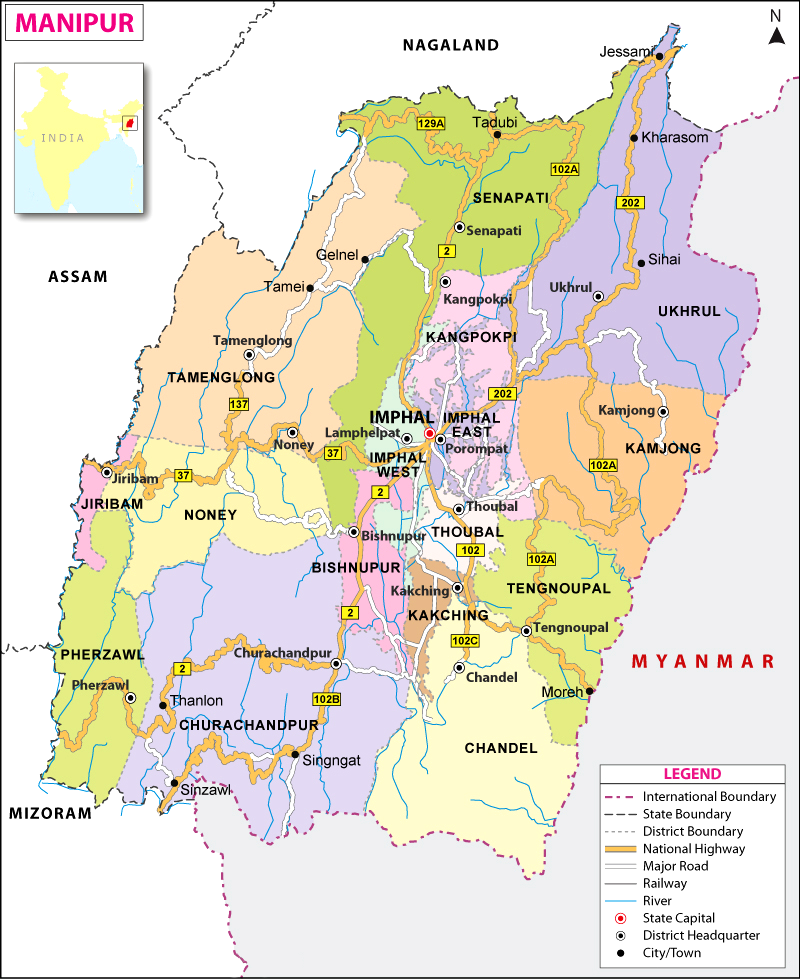Insurgency in Manipur | 23 Feb 2022
For Prelims: Armed Forces Special Powers Act (AFSPA), Rise of Insurgency in Manipur
For Mains: North East Insurgency and its Background, Challenges and Solutions.
Why in News?
Recently, the Centre Government has announced that it is ready to hold dialogue with insurgency groups in Manipur to bring lasting peace to the region.
- The emergence of insurgency in Manipur dates back to 1964 with the formation of the United National Liberation Front (UNLF), which still remains one of the most formidable militant outfits.
What are the Reasons for Rise of Insurgency in Manipur?
- Forced Merger: The rise of separatist insurgency in Manipur mainly attributed to perceived discontent over alleged “forced” merger of Manipur with the Union of India and the subsequent delay in granting it full-fledged statehood.
- While the erstwhile Kingdom of Manipur was merged with India on 15th October, 1949, it became a state only in 1972.
- Rise of Militancy: The later years saw a slew of militant outfits being formed, including the People’s Liberation Army (PLA), People’s Revolutionary Party of Kangleipak (PREPAK), Kangleipak Communist Party (KCP), and Kanglei Yawol Kanna Lup (KYKL), among others.
- These valley-based outfits have been demanding an independent Manipur.
- Spillover Effect of Greater Nagalim Demand: The Naga movement in neighbouring Nagaland spilled over into Manipur’s hill districts with the NSCN-IM controlling most of it while pressing for “Nagalim” (Greater Nagaland), which is perceived in the valley as a “threat” to Manipur’s “territorial integrity”.
- Valley-Hills Conflict: While the hills account for nine-tenths of Manipur’s geographical area, they are sparsely populated, with most of the state’s population concentrated in the valley.
- Naga-Kuki Conflict: In the early 1990s, the ethnic clashes between Nagas and Kukis led to the formation of several Kuki insurgent groups, which have now scaled down their demand from a separate Kuki state to a Territorial Council.
- The further continuance of insurgency led to the formation of smaller outfits like the Zeliangrong United Front (ZUF), People’s United Liberation Front (PULF) and other splinter groups.
What are the Steps Taken by the Government?
- Military Action:
- AFSPA: In 1980, the Centre declared the entire Manipur as a “disturbed area” and imposed the controversial Armed Forces Special Powers Act (AFSPA) to suppress the insurgency movement, which remains in force till date.
- Operation All Clear: Assam Rifles and the army had conducted operation “All Clear” in the hill areas, most of the militants’ hideouts had been neutralised, with many of them having shifted to the valley.
- Ceasefire Agreement:
- The NSCN-IM entered a ceasefire agreement with the Government of India in 1997, even as peace talks between them have still been continuing.
- The Kuki outfits under two umbrella groups, the Kuki National Organisation (KNO) and United People’s Front (UPF), also signed the tripartite Suspension of Operation (SoO) pacts with the Governments of India and Manipur on August 22, 2008.
- Many of their smaller outfits have however entered the SoO agreement with the state government, which has launched rehabilitation programmes for such groups.
- However, major valley-based militant outfits (Meitei groups) such as the UNLF, PLA, KYKL etc. are yet to come to the negotiating table.
What are the Challenges in Restoring Peace in Manipur?
- Many Conflicting Demands: The central government’s approach of a peaceful settlement with the militant outfits has proved counterproductive.
- Since, the demands of many of the outfits conflict with each other, any conventional agreement with one group becomes a cause for agitation by other groups.
- Proxy Groupings: Given that peace talks are on with the insurgents groups, there has been a tendency for the groups to continue the armed rebellion by another faction, with merely a change in nomenclature or by forming a new group.
- Politician-Insurgents Nexus: The nexus between the politicians and insurgents and criminals adds to the woes of the state.
- Some of the outfits operate as criminal gangsters thriving on extortion, kidnapping and contract killings.
- Nonetheless, miscreants take advantage of the unrest and extort funds, disguising themselves as insurgents.
- Besides, most of the security issues are politicised by the political parties to gain mileage for vote banks by enhancing controversies.
- Border State: Manipur being a border state, with a porous international border in a hostile jungle environment, the inflow of arms and trans-border movement of insurgent outfits who rely on external countries for training and other required logistics support are continuing.
Way Forward
- Good Governance: Good governance needs to be instituted in the state through a transparent government, fair judiciary system, respect for the rule of law, and the provision of the minimum basic amenities like hospitals, schools, police stations, etc.
- There is a need for political sincerity coupled with proper distribution of funds for the development of the state, both in the valley and the hills.
- This should be followed by economic development through government, semi-government and private entrepreneurship participation.
- Border Management: Before initiating any kind of counter-insurgency policy/operations, the Indo-Myanmar international border needs proper management.
- Engaging With People: The connectivity and intermingling amongst the diverse communities of Manipur with mainland India should be made more effective to encourage national integration.
- For this, Non-Governmental Organisations (Ngos), women’s associations, along with games and cultural programmes could be best utilised for restoring confidence among the valley and hill masses.

